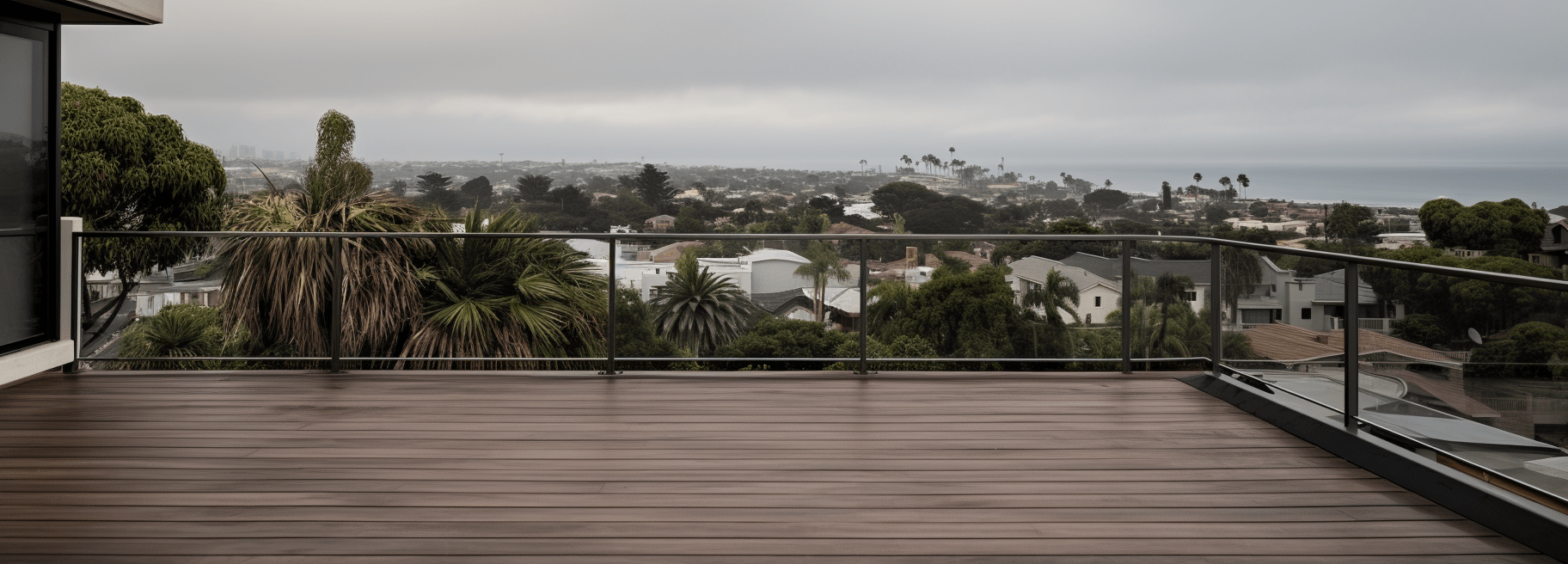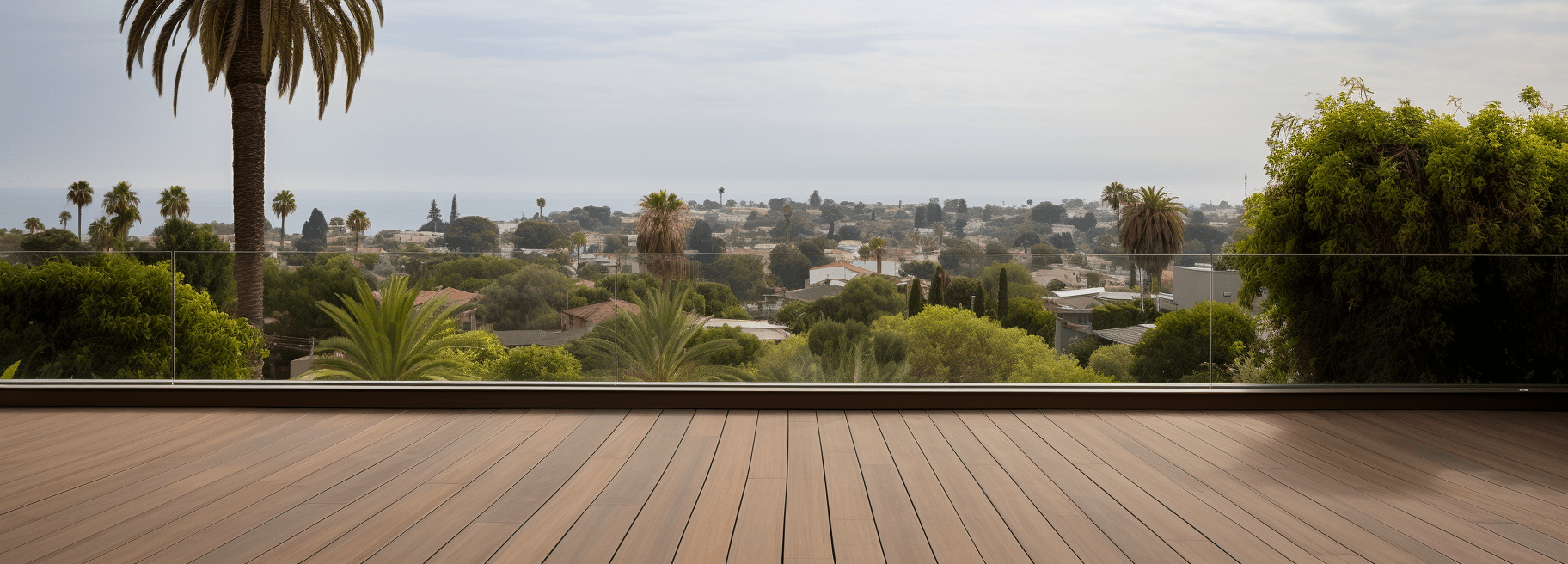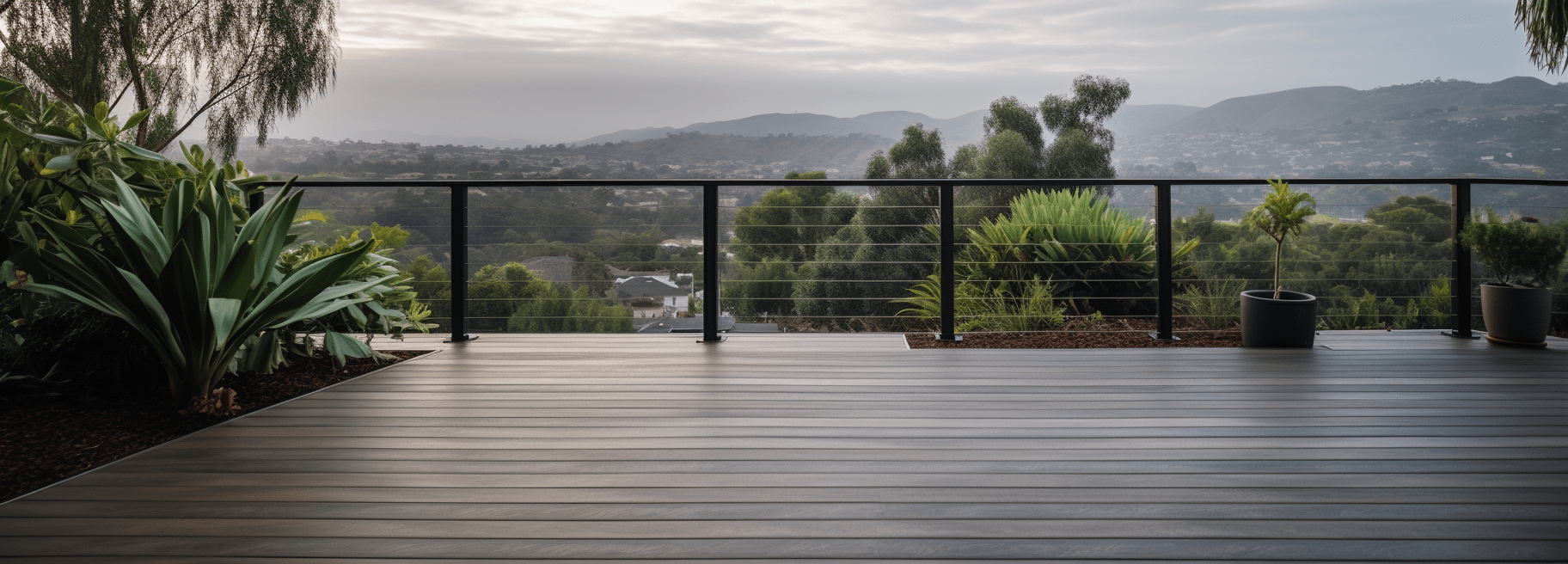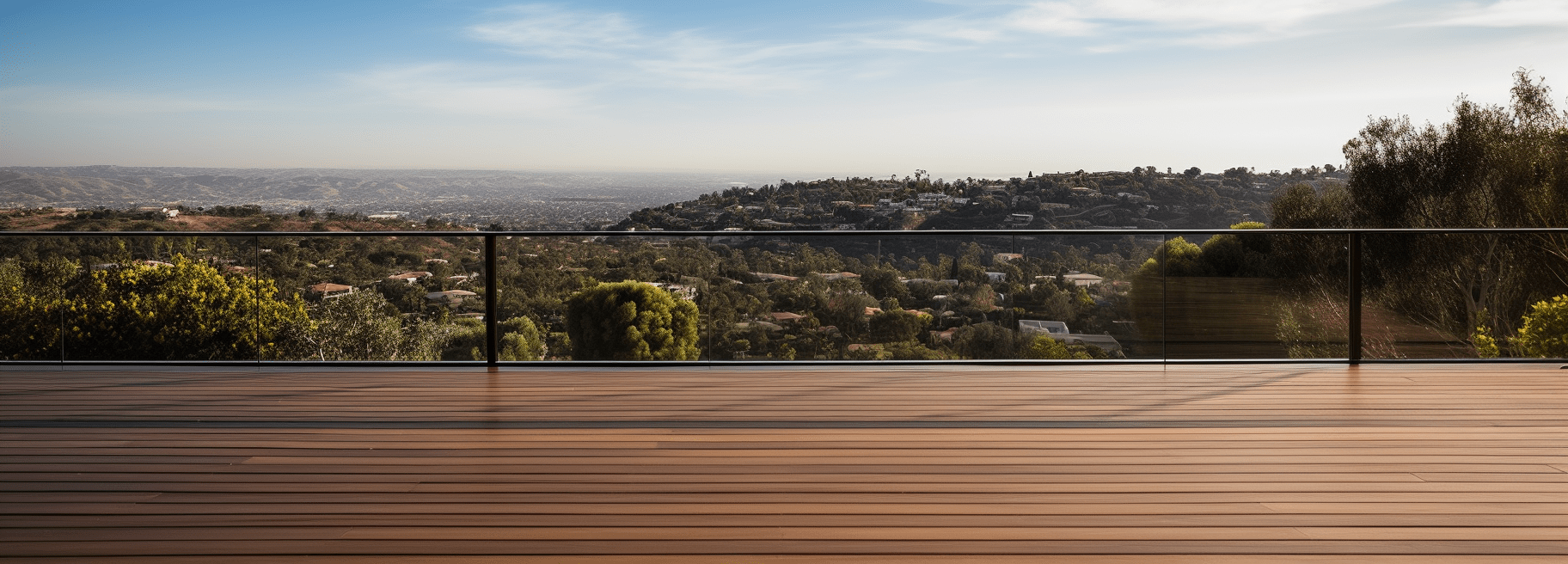1. Introduction
Composite wood decks have become a popular choice for homeowners and builders alike, especially in regions like San Diego. Their unique blend of wood fibers and plastic offers a durable, low-maintenance alternative to traditional wood decks. In this guide, we’ll delve deep into the world of composite wood decks tailored for the San Diego climate.
Why San Diego?
San Diego’s unique coastal climate, characterized by mild, wet winters and hot, dry summers, poses specific challenges for outdoor structures. Traditional wood decks, while aesthetically pleasing, often succumb to the effects of moisture, sun, and pests. Composite wood decks, with their blend of resilience and aesthetics, emerge as a fitting solution for San Diego homes.
2. Why Choose Composite Decking?
When it comes to decking, the choices are vast. From traditional woods like cedar and redwood to modern alternatives like PVC and composite, homeowners are spoilt for choice. However, composite decking stands out for several compelling reasons:
Durability:
Unlike traditional wood, composite decking doesn’t rot, warp, or splinter. It’s designed to withstand the elements, making it an ideal choice for San Diego’s varied climate. Whether it’s the scorching summer sun or the occasional winter rain, composite decks hold their own.
Low Maintenance:
Say goodbye to annual staining, sealing, or painting. Composite decks require minimal upkeep. A simple wash with soap and water is all it takes to keep them looking fresh. No more worries about termites or fungal decay!
Eco-Friendly:
Most composite decks are made from a mix of recycled wood fibers and plastic. This not only reduces the demand for virgin timber but also prevents plastic waste from ending up in landfills. It’s a win-win for the environment!
Aesthetics and Variety:
Composite decking comes in a range of colors and textures. Whether you’re looking for a natural wood look or a contemporary finish, there’s a composite deck to match your style.
3. Environmental Benefits of Composite Decking
In today’s world, where sustainability is more than just a buzzword, composite decking shines bright. Here’s how:
Recycled Materials:
Many leading brands, like Trex, use reclaimed wood and recycled plastic film in their products. This not only gives discarded materials a new lease of life but also reduces the carbon footprint associated with the production of new materials.
Reduced Deforestation:
By opting for composite decks, the demand for virgin timber goes down. This has a cascading positive effect on forests, reducing deforestation and helping maintain the planet’s green cover.
Longer Lifespan:
Composite decks last longer than their wooden counterparts. This means fewer replacements and, consequently, less waste. A typical composite deck can last anywhere from 25 to 30 years with proper care.
No Harmful Chemicals:
Traditional wood decks often require treatments with chemicals to enhance their lifespan. These chemicals can leach into the soil, harming the environment. Composite decks, on the other hand, don’t need such treatments, making them a more eco-friendly choice.
In conclusion, choosing composite decking is not just a decision for the present but also a nod to the future. It’s an investment in a sustainable, eco-friendly solution that stands the test of time and elements, especially in a beautiful coastal city like San Diego.
4. Cost Considerations
When considering a decking solution, especially in a prime location like San Diego, cost plays a pivotal role. Composite decking, while initially more expensive than traditional wood, offers long-term savings that can’t be ignored.
Initial Investment:
It’s no secret that composite decking comes with a higher upfront cost compared to traditional wood. The advanced materials, manufacturing processes, and the promise of durability contribute to this price tag. However, when you factor in the longevity and the minimal maintenance required, the scales start to tip in favor of composite decking.
Long-Term Savings:
While traditional wood decks might seem like a bargain initially, they come with recurring costs. Regular sealing, staining, and the occasional board replacement due to rot or pest damage can add up. Composite decking, with its resistance to most of these issues, requires little more than an occasional cleaning. Over a span of 10-15 years, homeowners can save a significant amount in maintenance costs alone.
Resale Value:
Properties in San Diego, given their prime location, can benefit from a high-quality composite deck. Prospective buyers often look for homes that require minimal upkeep. A composite deck can be a selling point, potentially offering a higher resale value for the property.
5. Composite Decking Materials Review
The world of composite decking materials is vast and varied. With numerous brands vying for attention, it’s essential to understand the nuances of each.
Material Composition:
At its core, composite decking is made from wood fibers and plastic. However, the quality and type of these materials can vary. Some brands use recycled plastic, while others opt for virgin materials. The wood fibers can range from softwoods like pine to more durable options like oak or maple.
Brands Overview:
- Trex: A market leader, Trex is known for its high-quality products made from 95% recycled materials. Their decks are known for durability and come with a 25-year warranty.
- TimberTech: Another top contender, TimberTech offers a range of products, from pure composite decks to PVC options. Their multi-toned designs mimic the natural look of wood.
- Fiberon: With a focus on sustainability, Fiberon decks are made from recycled wood and plastic. They offer a wide range of color options, from deep browns to grays.
Performance and Durability:
While all composite decks promise longevity, some brands outperform others. Factors like UV resistance, stain resistance, and tensile strength can vary. It’s essential to check reviews, ask for references, and, if possible, see the product in action before making a decision.
6. Installation and Maintenance
Installing a composite deck in San Diego requires precision and expertise. Given the city’s unique climate, ensuring the deck’s longevity starts with its installation.
Installation Best Practices:
- Foundation: Ensure a solid foundation. Whether you’re using concrete piers or helical piles, the foundation must be stable to support the deck.
- Spacing: Composite materials can expand and contract with temperature changes. Proper spacing between boards is crucial to accommodate this movement.
- Fasteners: Use high-quality fasteners, preferably stainless steel, to prevent rust and corrosion. Some brands offer hidden fastening systems for a cleaner look.
Maintenance Tips:
- Cleaning: Use a mild soap solution and a soft brush to clean the deck. Avoid power washing as it can damage the material.
- Stain Removal: For tough stains like wine or oil, use a composite deck cleaner. Always test a small area before applying it to the entire deck.
- Avoid Scratches: While composite decks are resistant to scratches, it’s best to be cautious. Use protective mats under grills and furniture.
In conclusion, while composite decks offer a low-maintenance solution, proper installation and occasional care can ensure they look pristine for years. Whether you’re enjoying a sunny day in San Diego or hosting a barbecue night, a well-maintained composite deck can be the perfect backdrop.
7. Custom Deck Designs in San Diego
San Diego, with its picturesque landscapes and coastal charm, offers homeowners a unique opportunity to get creative with their deck designs. Composite decking, given its versatility, can be tailored to match the city’s vibe and the homeowner’s personal style.
Tailoring to San Diego’s Landscape:
San Diego’s coastal areas, canyons, and hilly terrains provide a backdrop that can inspire deck designs. Elevated decks with panoramic views of the ocean, multi-tiered decks cascading down a hillside, or decks with built-in seating overlooking a canyon can integrate seamlessly with the natural surroundings.
Features and Add-ons:
- Pergolas and Gazebos: These structures can provide shade, essential for San Diego’s sunny days. Whether it’s a simple pergola with climbing vines or a fully furnished gazebo, these additions can elevate the deck’s aesthetics and functionality.
- Fire Pits and Heaters: San Diego evenings can get chilly. A built-in fire pit or space heaters can make the deck a cozy spot year-round.
- Lighting: Ambient lighting can set the mood. From string lights to in-built LED fixtures, the options are vast and varied.
8. Decking Solutions for Different Needs
Every homeowner in San Diego has unique needs when it comes to decking. Some might prioritize aesthetics, while others might focus on durability or eco-friendliness. Composite decking offers solutions that cater to these varied requirements.
Residential vs. Commercial Decking:
- Residential: Homeowners might prioritize aesthetics, comfort, and safety. Brands that offer a wide range of designs, textures, and colors might be preferred. Features like slip-resistance and UV protection can also be crucial.
- Commercial: For commercial spaces like restaurants or resorts, durability and maintenance might be paramount. Decks that can withstand heavy foot traffic, are stain-resistant, and require minimal upkeep might be ideal.
Specialty Coatings and Finishes:
Composite decking can be customized further with specialty coatings. UV-resistant coatings can prevent fading, while anti-slip coatings can enhance safety. Some brands also offer finishes that mimic the texture and grain of exotic woods, giving homeowners the luxury feel without the associated maintenance.
9. Addressing Common Questions
When considering composite decking in San Diego, homeowners often have a plethora of questions. Addressing these can help in making an informed decision.
How much does a 20×20 composite deck cost?
The cost can vary based on the brand, design, and additional features. On average, homeowners might spend between $8,000 to $12,000 for a 20×20 deck. This includes materials and labor.
Is composite decking cheaper than wood right now?
While the initial cost of composite decking is higher than wood, the long-term savings in maintenance, durability, and longevity make it a cost-effective choice in the long run.
How much would a 12×12 composite deck cost?
A 12×12 deck might cost between $3,500 to $5,500, depending on the chosen brand, design, and any additional features.
Is it cheaper to build a wood deck or composite deck?
The initial investment for a wood deck might be lower. However, when considering maintenance costs like staining, sealing, and potential repairs, composite decking can be more economical over its lifespan.
In conclusion, while the upfront cost of composite decking might seem steep, the benefits it offers in terms of durability, aesthetics, and low maintenance make it a worthy investment, especially in a city like San Diego with its unique climate and lifestyle demands.
10. Safety Considerations
Safety is paramount when it comes to decking, especially in a bustling city like San Diego where decks are frequently used for gatherings and relaxation.
Fire Resistance:
San Diego, with its occasional wildfires, demands materials that can withstand high temperatures. Composite decking is often designed to be fire-resistant, ensuring that it doesn’t easily ignite. Brands like Trex have products specifically designed to meet stringent fire safety standards.
Slip-Resistant Features:
Morning dew, occasional rain, or pool splashes can make decks slippery. Composite decking often comes with slip-resistant features, ensuring that the surface provides grip even when wet. This is especially crucial for homes with children or elderly residents.
Weight Bearing Capacity:
Decks are often the venue for gatherings, barbecues, or lounging. It’s essential that they can bear weight without buckling. Composite decks, with their robust construction, can handle significant weight, ensuring they remain stable and secure even with heavy furniture or during large gatherings.
Chemical Treatments:
Unlike traditional wood, composite decking doesn’t require treatments with potentially harmful chemicals to ward off pests or prevent rot. This ensures that the deck remains safe for pets and children, and there’s no risk of chemicals leaching into the ground.
11. Composite Decking vs. Other Materials
When considering decking options in San Diego, homeowners often compare composite decking with other available materials.
Composite vs. Hardwood:
- Aesthetics: While hardwoods like teak or ipe have a natural beauty, composite decking offers a wide range of colors and textures, some even mimicking the look of real wood.
- Maintenance: Hardwoods require regular oiling and sealing to maintain their look and prevent decay. Composite decking, on the other hand, requires minimal maintenance.
- Cost: Hardwoods can be expensive, both in terms of material and installation. Composite decking, while also a premium option, can offer better value over time given its durability and low maintenance.
Composite vs. Softwood:
- Durability: Softwoods like pine or cedar can be prone to rot, pests, and decay, especially in the humid San Diego climate. Composite decks are designed to resist these issues.
- Environmental Impact: While softwoods are renewable, they require regular logging. Composite decking, often made from recycled materials, can be a more eco-friendly option.
Composite vs. PVC:
- Feel: PVC decks can get very hot under the San Diego sun, making them uncomfortable to walk on. Composite decks, with their wood content, tend to remain cooler.
- Environmental Impact: Composite decks, especially those made from recycled materials, have a lower carbon footprint compared to PVC decks.
12. Environmental Impact of Composite Decking
In today’s eco-conscious world, understanding the environmental implications of our choices is crucial. Composite decking, with its blend of wood fibers and plastics, offers both benefits and challenges from an environmental perspective.
Recycled Materials:
Many composite decking brands prioritize sustainability by using recycled materials. For instance, some brands utilize reclaimed wood fibers and recycled plastics, reducing the need for virgin materials and minimizing waste. This approach not only conserves resources but also reduces the carbon footprint associated with the production of new materials.
Durability and Longevity:
One of the significant environmental benefits of composite decking is its longevity. Unlike traditional wood decks that might need replacement every 10-15 years, composite decks can last several decades with proper care. This reduced frequency of replacement means fewer resources are used over time, and less waste is generated.
Reduced Maintenance:
Traditional wood decks often require chemical treatments to ward off pests, mold, and decay. These chemicals can leach into the soil, potentially harming the environment. Composite decks, being resistant to most of these issues, eliminate the need for such treatments, leading to a reduced environmental impact.
Challenges:
While composite decking offers several environmental benefits, it’s not without challenges. The blend of wood and plastic makes recycling composite decking at the end of its life more complicated. Additionally, while many brands use recycled plastics, some still rely on virgin plastics, which have a higher environmental cost.
In conclusion, while composite decking presents a more environmentally friendly alternative to traditional wood, consumers should research brands and their environmental practices to make the most sustainable choice.
13. Trends in Composite Decking for San Diego
San Diego, with its blend of modern urban spaces and scenic natural beauty, often sets the stage for emerging trends in outdoor living. Composite decking, given its versatility, has seen several trends emerge in recent years.
Color Variations:
Gone are the days when composite decking was available in just a few basic colors. Today, homeowners can choose from a vast palette, from coastal grays to deep mahoganies. Some brands even offer boards with multi-tonal streaking, mimicking the natural variations of hardwood.
Textured Finishes:
To enhance the authentic feel, many composite decking options now come with textured finishes. Whether it’s a subtle wood grain or a more pronounced embossed pattern, these textures add depth and character to the decks.
Integrated Lighting:
With the increasing focus on outdoor living, integrated lighting solutions for composite decks have gained popularity. Whether it’s LED strips along the railings or in-built floor lights, these solutions enhance the deck’s ambiance and safety.
Custom Inlays:
For homeowners looking to add a touch of uniqueness to their decks, custom inlays have become a trend. Whether it’s a nautical compass, a family crest, or any other design, composite materials can be crafted to create these personalized inlays.
Eco-friendly Options:
With the rising emphasis on sustainability, eco-friendly composite decking options have seen a surge in popularity. Brands that use recycled materials, have a lower carbon footprint, and adopt sustainable manufacturing practices are increasingly preferred by environmentally-conscious homeowners.
In essence, the trends in composite decking in San Diego reflect the city’s ethos – a blend of style, functionality, and a deep respect for nature. As technology advances and consumer preferences evolve, it’s exciting to envision where the future of composite decking will lead.
Conclusion
Composite decking has revolutionized the way homeowners in San Diego and beyond approach outdoor living spaces. Its blend of durability, aesthetics, and environmental benefits makes it a compelling choice for those looking to enhance their homes. As with any significant investment, it’s essential to stay informed, understand the trends, and weigh the pros and cons. San Diego’s unique climate and lifestyle demands a decking solution that’s both functional and beautiful, and composite decking rises to the occasion. Whether you’re a homeowner looking to renovate or a contractor seeking the best for your clients, composite decking offers a versatile and sustainable solution.
FAQs
1. How long does composite decking last?
Composite decking can last 25-30 years or even longer with proper care and maintenance. Its durability surpasses traditional wood, which might require replacement every 10-15 years.
2. Is composite decking maintenance-free?
While composite decking requires significantly less maintenance than wood, it’s not entirely maintenance-free. Occasional cleaning with soap and water can help maintain its appearance and prevent mildew.
3. Can composite decking fade over time?
High-quality composite decking is designed to be UV-resistant, reducing the chances of fading. However, like any outdoor material, minimal fading over time is natural.
4. Is composite decking eco-friendly?
Many composite decking brands use recycled materials, making them more sustainable than traditional wood. However, it’s essential to research individual brands to understand their environmental practices.
5. How does composite decking handle water and moisture?
Composite decking is designed to be water-resistant, making it an excellent choice for pool areas, coastal homes, or regions with frequent rain.
6. Can I install composite decking myself?
While it’s possible for DIY enthusiasts with the right tools and knowledge to install composite decking, it’s often recommended to hire professionals to ensure the best results and longevity.
With the right information and a clear vision, homeowners can transform their outdoor spaces into beautiful, long-lasting retreats. Composite decking, with its myriad of benefits, stands as a testament to innovation in the world of outdoor living.
Looking for Artificial hedges for your new home? Visit Geranium Street for more information.





